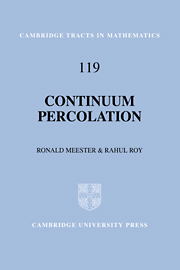Book contents
- Frontmatter
- Contents
- Preface
- 1 Introduction
- 2 Basic methods
- 3 Occupancy in Poisson Boolean models
- 4 Vacancy in Poisson Boolean models
- 5 Distinguishing features of the Poisson Boolean model
- 6 The Poisson random-connection model
- 7 Models driven by general processes
- 8 Other continuum percolation models
- References
- Index
4 - Vacancy in Poisson Boolean models
Published online by Cambridge University Press: 05 November 2011
- Frontmatter
- Contents
- Preface
- 1 Introduction
- 2 Basic methods
- 3 Occupancy in Poisson Boolean models
- 4 Vacancy in Poisson Boolean models
- 5 Distinguishing features of the Poisson Boolean model
- 6 The Poisson random-connection model
- 7 Models driven by general processes
- 8 Other continuum percolation models
- References
- Index
Summary
In this chapter we discuss the properties of the vacant components in the Poisson Boolean model. Unlike the occupied components in the Poisson Boolean model, where the structure of the occupied regions arises because of placing balls around the Poisson points, the vacancy structure arises in the negative sense, i.e., in the absence of any ball covering a point. This lack of a structure to describe directly the vacancy configuration is a limitation due to which it is often harder to establish results concerning vacancy.
In the study of percolation on discrete graphs, the vacancy configuration is usually thought of as the ‘dual’ of the occupancy structure. In that sense we shall occasionally refer to the vacant region as the dual of the occupied region. This nomenclature is more informal than exact, because in the discrete percolation models, the dual structure has a legitimate construct of its own, rather than being just an appendage of the occupied structure.
We shall define critical densities via vacancy and show that in two dimensions, when the radii are bounded, λ∗H = λ∗T/sub>, where these notations have the same meaning in the vacancy as they had (without the superscript) in the occupancy. In addition, we shall show that in two dimensions, the critical densities arising from the occupancy agree with that arising from vacancy. We shall also establish a uniqueness result for the vacant component as in Section 3.6 of Chapter 3.
Information
- Type
- Chapter
- Information
- Continuum Percolation , pp. 91 - 121Publisher: Cambridge University PressPrint publication year: 1996
